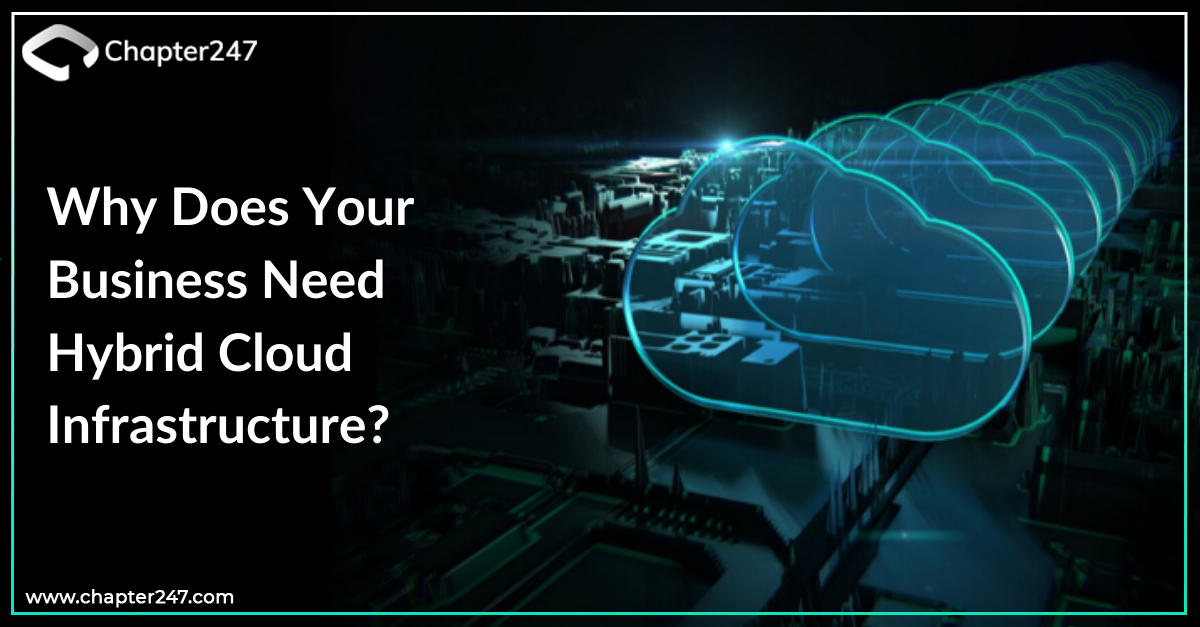Cloud computing is the third wave of the digital revolution, and hybrid cloud architecture is the chief driver of this new wave! Hybrid Cloud represents the modern version of adopting cloud computing that warranties innovation at high-speed.
Why do businesses need Hybrid cloud?
Considering cloud computing as a solution no longer invites any discussion of skepticism in the world of business today. More than 77% of businesses have at least one application or a single process or a part of their overall infrastructure on the cloud. There is an increased level of comfort when it comes to cloud adoption but the matter that requires serious consideration and discussion is about which businesses can move to the cloud.
Gartner predicts that by the end of 2020, 90% of the organizations will adopt hybrid infrastructure management. This prediction surely doesn’t come as a surprise as a hybrid environment can optimize systems based on their unique environments. This, in turn, accelerates the speed of delivery of services as well as applications.
Get to know more about the Hybrid cloud environment
There have been many debates surrounding what the exact definition of the term should be. But in simple terms, it is the merger of two cloud computing systems namely the public and the private used concurrently to address challenges of severed workloads through a single system of delivery.
The hybrid cloud is much more than an emerging trend in 2020. It is a set of state-of-art technology and IT operating models that have figuratively reshaped how organizations of the future will function now and later into the future. Hybrid cloud management is helping businesses amalgamate on-premise, private, and public cloud capabilities, doing its bit by sharing data and migrating apps between different clouds. By using a hybrid approach, agile IT teams are becoming swift as they manage through changing business needs.
In an Index survey conducted in 2019 among enterprises, interestingly 85% of the respondents chose hybrid models as their basic IT operating model. This survey was taken among more than 2000 IT consultants and strategists in their organizations. 49% of them believed that considering the future, hybrid clouds met all their needs. The growth in the hybrid cloud market has been significant compared to other cloud services because as per Mordor Intelligence, the hybrid cloud market is expected to reach 128.01 billion by 2025!
Hybrid cloud – How do they work?
The infrastructure that supports the hybrid cloud usually includes a network, servers, and virtualization software. The servers conduct hosting services of the data while displaying it remotely through the network. The virtualization software allows for remote resources like the desktop to be displayed remotely. Since it is a combination of both in-house and 3’rd party public cloud service providers the back-end components are placed in two different locations that are on-premises at the business data center and with the public cloud service provider. Virtualization software lets the cloud service providers host compound operating systems on one server, maximizing the resources.
6 reasons you should move to a hybrid cloud
We have great reasons for the growing popularity of the hybrid cloud platform. In this section, we intend to explore through them, for a better conviction in its abilities.
1. Scalability demands
What the companies face: A lack of flexibility and scalability restricts growth and renders businesses with the same old tools to function.
How Hybrid cloud set- up helps: The Hybrid cloud allows businesses to choose the best cloud to run a particular workload and also to manage critical application data. A hybrid cloud system provides essential tools and data for innovations. Businesses are no longer constrained to function with on-site availability. By using both public and private cloud the impact as well as the scalability of workloads increases paving way for advanced infrastructure planning.
Considering if an application has an unpredictable flow of demand or a dynamic usage format, public cloud services are extremely elastic in nature and fit the bill perfectly. But for those organizations where workloads are relatively predictable, working on private cloud results in a lower TCO or total cost of ownership. Workloads are easily transportable between clouds. As demand changes, resources can be easily scaled up and down.
 2. Meeting security needs
2. Meeting security needs
What the companies face: the need for tighter security and compliance adherence
How Hybrid cloud set- up helps: For most businesses the matter of inter-cloud security is the biggest reason to adopt hybrid cloud. When it comes to specific security and compliance requirements, hybrid cloud suits these needs. Public cloud environments are more likely to expose their network security. Hybrid cloud allows extensive control in terms of design and architecture thereby increasing the level of data security over public cloud solutions.
Hybrid clouds also ensure high availability and disaster recovery with agile backup services. A business can keep critical data in a private cloud and a well-planned recovery ecosystem in a public cloud.
 3. Flexibility
3. Flexibility
What the companies face: A lack of flexibility to switch between clouds and to choose the cloud platform is a problem
How Hybrid cloud set- up helps: Companies have started preferring to work on hybrid clouds as it provides interoperability between different cloud types. It allows businesses to use one single type of cloud and then later switch to the other type if that is a much efficient option. There could be several times when an application in a business department requires rapid access to IT and hence they may favor something that is swift enough to fulfill the demand. In that public cloud services at the initial level proves to be far more beneficial.
There is also a lot of agility in the operation when it comes to the Hybrid cloud system. Simplification of data has been possible with the hyper-converged infrastructure that has simplified data centers with ML-driven automation. This has far-fetched results as it has led to a much more strengthened and reinforced dashboards. The presence of HyperConverged Infrastructure has reduced the time and overall costs of managing data and app development.
4. Ensuring cloud exchangeability
What the companies face: When businesses suffer losses or if their services are down, they cannot afford to stop their daily operation to make time for transitioning to the cloud.
How Hybrid cloud set- up helps: Businesses have long-term contracts on cloud infrastructure hence, they are not in that state of control to convert their business entirely on the cloud. Hybrid cloud provides a great alternative of merging the current infrastructure with a private cloud. This limits downtime and slows the transition process giving employers more time to train employees. Existing infrastructures are not changed but businesses can easily move towards this new cloud system.
5. Costs
What the companies face: Dealing with costs can be challenging.
How Hybrid cloud set- up helps: The presence of a hybrid cloud structure enables businesses to make their IT spending economic. It lets businesses leverage the resources they already own needless for them to adopt newer tools. A mix of the cloud ensures the upfront costs of installing in-house technology is eliminated with only a plain payment monthly to simplify costs. A majority of the public cloud services charge on the basis of the operational expenditure model meaning that businesses pay as per the usage on a monthly basis.
 6. Augmented mobility for data and apps
6. Augmented mobility for data and apps
What the companies face: An almost disabled system of mobility for apps which is important to control costs and manage resources.
How Hybrid cloud set- up helps: Hybrid cloud environment is considered critical for managing resources and cutting down costs. Customers now are seeking real-world app and data mobility and this is possible with hybrid cloud infrastructure. In order to achieve this, businesses are ready to migrate their applications as well as data to the best cloud and also change when the business conditions change.
As more and more companies converge public and private cloud, challenges will arise but the benefits of hybrid cloud-like agility, cost, app data mobility will help them to find the right balance at every such pressing situation.
Turn to Chapter 247 for implementation
No matter what the size of your business is, planning a hybrid cloud strategy can be difficult especially if your IT department is not as experienced. Turning to a trusted cloud service provider like us can help prepare your organization for a successful transformation. We possess the right skills to successfully plan and implement cloud migration.
As a software service provider we understand where the problems may arise and we will help you navigate through them to achieve results. Our pragmatic approach towards cost and security landscape can help you in working with your vendors for additional savings. As a trusted cloud computing solutions provider, we will develop a futuristic hybrid cloud strategy and continue to deliver a fully managed solution for the entire lifecycle of the project.
Discuss with our agile cloud experts and let’s get to work!








